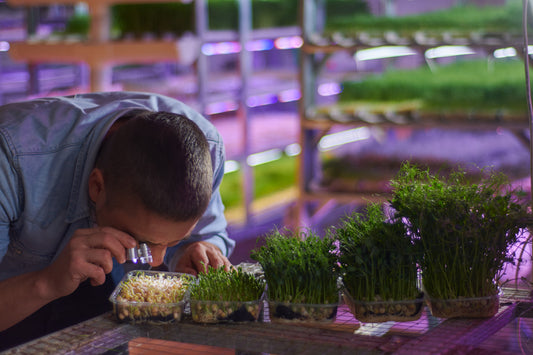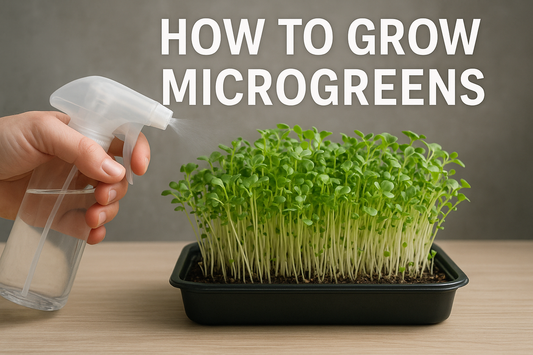
Step-by-Step Guide: How to Grow Your First Batch of Microgreens
Share
Hello, friends! This is Ivan “Green Chief,” and today I’m sharing a practical guide for everyone who wants to grow microgreens at home. In this article, you will learn where to begin, which materials and tools to use, and how to properly water and light your plants. Special attention is given to the important procedure of pre-soaking seeds for certain crops such as peas and sunflower, which significantly accelerates germination and increases yield.
1. Preparation of Materials and Tools
Before you start, it is essential to gather all the necessary items to create optimal conditions for your microgreens:
-
Seeds.
Choose seeds specially intended for microgreens as they offer high germination rates. Popular choices include radish, peas, sunflower, and cress. -
Tray or Container.
Use a shallow tray (3–5 cm deep) with drainage holes or a plastic container. This ensures even distribution of the substrate and prevents waterlogging. -
Substrate.
It is recommended to use coconut peat, horticultural fiber, or a flax mat, which retain moisture well and promote healthy growth. -
Spray Bottle.
Use a spray bottle to ensure the substrate’s surface is evenly moistened. -
Lighting.
If natural light is insufficient, use grow lights that provide the optimal spectrum for photosynthesis.
2. Sowing Microgreens: Preparing for Planting
Once all the tools are ready, you can proceed to sowing your microgreens. Adhering to the correct method is crucial:
-
Tray Preparation.
Evenly spread the chosen substrate in your tray and lightly compact it to prevent it from crumbling during sowing. -
Even Distribution of Seeds.
Distribute the seeds over the substrate so that they are not too densely packed. Avoid over-sowing since dense seeding reduces oxygen and light availability to each sprout. -
Covering the Seeds.
Lightly cover the seeds with a thin layer of substrate to ensure they are well anchored without burying them too deeply. -
Initial Moistening.
Use the spray bottle to moisten the substrate evenly, taking care to avoid overwatering.
3. Pre-Soaking Seeds: Specifics for Peas and Sunflower
Some crops require pre-soaking to speed up germination and improve sprout yield. This is especially true for pea and sunflower seeds:
-
Peas.
Soak pea seeds in room-temperature water for 8–12 hours. This softens the seed coat, speeding up germination. -
Sunflower.
Similarly, sunflower seeds should be soaked for 8–12 hours to absorb moisture rapidly and begin germination.
After soaking, rinse the seeds thoroughly with cold water to remove excess moisture before sowing.
4. Common Mistakes Beginners Make and How to Avoid Them
Even if the process seems simple, many beginners make mistakes. Here are the most common:
-
Over-Sowing.
Excessive seeding leads to poor ventilation, insufficient light, and mold formation. Strive to distribute seeds evenly so that each sprout has enough space to develop. -
Improper Watering.
Overwatering can cause rot, while too little moisture slows germination. Use a spray bottle for even misting and monitor the substrate’s condition. -
Insufficient Lighting.
Microgreens require both natural and artificial light. Inadequate light makes the plants thin and pale, so ensure at least 12–16 hours of light daily.
5. Tips on Lighting and Watering
Effective lighting and proper watering are key:
-
Lighting.
-
Place the tray on a windowsill with maximum natural light, preferably on the south or east side.
-
During winter or low natural light conditions, use grow lights that provide a full spectrum for photosynthesis.
-
Use timers to maintain a consistent light schedule of 12–16 hours daily.
-
Watering.
-
Mist the substrate evenly to prevent both overwatering and drying out.
-
Use water at room temperature to avoid shocking the seeds.
6. Conclusion
Growing microgreens is both an exciting and healthy hobby that provides you with fresh, natural greens all year round. Proper preparation of materials, adherence to sowing techniques, and special attention to pre-soaking pea and sunflower seeds will ensure a steady harvest. Avoid common mistakes such as over-sowing, improper watering, and insufficient lighting to keep your sprouts robust and healthy.
I hope this detailed guide helps you take your first steps in the world of microgreens. If you have any questions or need additional equipment, visit my online store “Green Chief.” Experiment and enjoy the freshness and benefits of home-grown microgreens.











